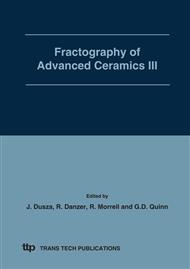p.231
p.237
p.244
p.252
p.260
p.267
p.275
p.279
p.283
The Influence of Corrosion in an Aqueous Solution of NaCl on Fracture and Strength of Various Structural Ceramics
Abstract:
The present work studies the corrosion of three most widely used types of structural ceramics – silicon nitride, solid state sintered alumina and liquid phase sintered alumina – in 3 % aqueous solutions of sodium chloride at temperatures up to 290 °C and pressures up to 7 MPa. The corrosion of silicon nitride was controlled by attack of Si3N4 matrix grains, while yttrium oxynitride amorphous grain boundary phase was corrosion resistant. Corrosion of Si3N4 in reference media -distilled water - at 290 °C was characteristic by formation of passivation layer, which hindered further dissolution of silicon nitride matrix. The presence of sodium chloride resulted in formation of discontinuous layer of corrosion products, resulting in more severe corrosion than in distilled water. The corrosion of liquid phase sintered alumina was mainly attributed to congruent dissolution of SiO2 and CaO from grain-boundary amorphous film, which was accelerated at higher temperature, and accompanied by precipitation of siliceous phases from oversaturated solution at 200 °C. Pure polycrystalline alumina corroded by loss of alumina grains, which did not dissolve in the corrosion media. The corrosion impaired significantly the fracture strength of silicon nitride, creating new, corrosion related defects at the surface, while the influence of corrosion on fracture strength of polycrystalline aluminas was negligible.
Info:
Periodical:
Pages:
260-266
Citation:
Online since:
March 2009
Keywords:
Price:
Сopyright:
© 2009 Trans Tech Publications Ltd. All Rights Reserved
Share:
Citation:


